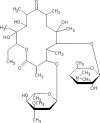Orally administered erythromycin in rainbow trout (Oncorhynchus mykiss): residues in edible tissues and withdrawal time
- PMID: 17194823
- PMCID: PMC1803102
- DOI: 10.1128/AAC.01002-06
Orally administered erythromycin in rainbow trout (Oncorhynchus mykiss): residues in edible tissues and withdrawal time
Abstract
Aquaculture production has notably increased in the last decades, mainly thanks to intensive farming. Together with market globalization, this gives rise to the spreading of several fish diseases, thus increasing the demand for veterinary drugs for aquatic species. Nonetheless, very few chemicals are registered for use in aquaculture, and fish farmers are often forced to resort to off-label use of drugs authorized for other food-producing animal species. Rainbow trout is the major farmed fish species in Italy and the second one in Europe. Erythromycin is the antibiotic of choice against gram-positive cocci, the major concern for trout farming, but it is not yet registered for aquaculture use in most European countries. The aim of this study was to follow the depletion of erythromycin in rainbow trout (Oncorhynchus mykiss), after its administration at 100 mg kg(-1) trout body weight day(-1) for 21 days through medicated feed (water temperature, 11.5 degrees C). Erythromycin residues in fish muscle plus skin in natural proportion were determined by a validated liquid chromatography-electrospray ionization-tandem mass spectrometry method. Interpolation of our data, following European Agency for the Evaluation of Medicinal Products guidelines, gives a withdrawal time of 255 degrees C-days ( degrees C-day = water temperature x days), thus showing that the general value (500 degrees C-day) recommended by the Council Directive (EEC) no. 82/2001 for off-label drug use in aquaculture would be too conservative in this case, with excessive costs for the farmers. Our study provides preliminary data for a more prudent use of erythromycin in rainbow trout, suggesting a possible withdrawal time after treatment.
Figures


References
-
- Akinbowale, O. L., H. Peng, and M. D. Barton. 2006. Antimicrobial resistance in bacteria isolated from aquaculture in Australia. J. Appl. Microbiol. 100:1103-1113. - PubMed
-
- Associazione Piscicoltori Italiani. 2005. La piscicoltura Italiana. Anno 2004. http://www.api-online.it.
-
- Azevedo, P. A., J. Van Milgen, S. Leeson, and D. P. Bureau. 2005. Comparing efficiency of metabolizable energy utilization by rainbow trout (Oncorhynchus mykiss) and Atlantic salmon (Salmon salar) using factorial and multivariate approaches. J. Anim. Sci. 83:842-851. - PubMed
-
- Bailey, G. S., D. E. Williams, J. S. Wilcox, P. M. Loveland, R. A. Coulombe, and J. D. Hendricks. 1988. Aflatoxin B1 carcinogenesis and its relation to DNA adduct formation and adduct persistence in sensitive and resistant salmonid fish. Carcinogenesis 9:1919-1926. - PubMed
MeSH terms
Substances
LinkOut - more resources
Full Text Sources
Medical

